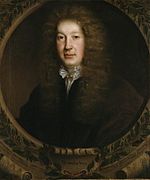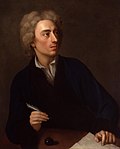Heroic couplet
A heroic couplet is a traditional form for
Example
A frequently-cited example[by whom?] illustrating the use of heroic couplets is this passage from Cooper's Hill by John Denham, part of his description of the Thames:
O could I flow like thee, and make thy stream
My great example, as it is my theme!
Though deep yet clear, though gentle yet not dull;
Strong without rage, without o'erflowing full.
History
The term "heroic couplet" is sometimes reserved for couplets that are largely closed and self-contained, as opposed to the
Variations
English heroic couplets, especially in Dryden and his followers, are sometimes varied by the use of the occasional alexandrine, or hexameter line, and triplet. Often these two variations are used together to heighten a climax. The breaking of the regular pattern of rhyming pentameter pairs brings about a sense of poetic closure. Here are two examples from Book IV of Dryden's translation of the Aeneid.
Alexandrine
Her lofty courser, in the court below,
Who his majestic rider seems to know,
Proud of his purple trappings, paws the ground,
And champs the golden bit, and spreads the foam around.— (ll. 190–193)
Alexandrine and Triplet
My Tyrians, at their injur’d queen’s command,
Had toss’d their fires amid the Trojan band;
At once extinguish’d all the faithless name;
And I myself, in vengeance of my shame,
Had fall’n upon the pile, to mend the fun’ral flame.— (ll. 867–871)
Modern use
Twentieth-century authors have occasionally made use of the heroic couplet, often as an allusion to the works of poets of previous centuries. An example of this is Vladimir Nabokov's novel Pale Fire, the second section of which is a 999-line, 4-canto poem largely written in loose heroic couplets with frequent enjambment.[2] Here is an example from the first canto:
And then black night. That blackness was sublime.
I felt distributed through space and time:
One foot upon a mountaintop. One hand
Under the pebbles of a panting strand,
One ear in Italy, one eye in Spain,
In caves, my blood, and in the stars, my brain.— (Canto One. 147–153)
The use of heroic couplets in translations of
One mounted, one released the other’s coat,
The autumn maples dyed with roads remote.
Red miles cast dust upon the faring steed;
He disappear’d behind the berry mead.
One stay’d as shadow through the hours of night,
One left alone for great miles out of sight.
Who had cut up the rounded moon in two,
Half shining cushions, half on miles that grew?— (VI. 1519-1526)
See also
- Metre (poetry)
- Iambic pentameter
- Foot (prosody)
- Heroic verse
References
- ^ Hobsbaum, Philip. Metre, Rhythm and Verse Form. Routledge (1996) p.23
- ^ Ferrando, Ignasi Navarro (1996). In-roads of Language: Essay in English Studies. Universitat Jaume I. p. 125.
- ^ "Tái hiện vẻ đẹp thi ca của Truyện Kiều bằng tiếng Anh". Nhân Dân. 22 November 2021. Retrieved 7 January 2022.
- ^ Binh, Nguyen (2021). The Tale of Kiều: A New Cry of Heart-Rending Pain. Writers Association Publishing House.



